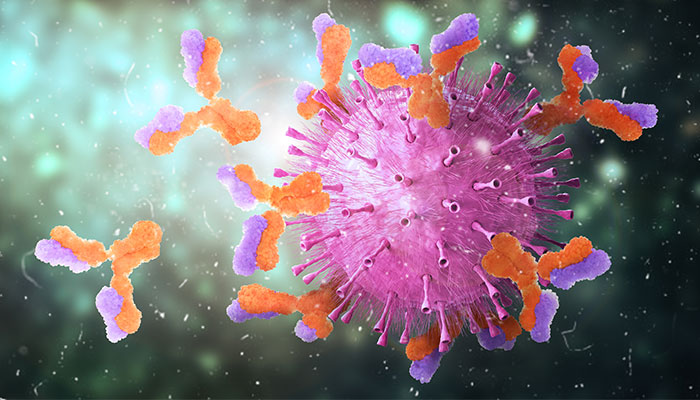HOW CAN WE HELP YOU? Call 1-800-TRY-CHOP
In This Section
CHOP Researcher to Lead U.S. Immunodeficiency Network

Dr. Kathleen Sullivan is leading USDINET in its work to improve the state of genetic diagnostics for inborn errors of immunity.
Immunologist Kathleen E. Sullivan, MD, PhD, often tells the story of a patient she met when he was 7 years old to illustrate the long, winding road that children with primary immunodeficiency diseases take to diagnosis and eventual treatment.
"He was a twig, a really small child who looked unwell," said Dr. Sullivan, chief of the Division of Allergy and Immunology at Children's Hospital of Philadelphia. "He was sick all the time, and no one knew why. He was angry. His parents were always keeping him inside to stop him from getting infections."
Today, following years of treatment at CHOP, that scrawny kid is a police officer in New York City, whom Dr. Sullivan describes as a "big, bear-huggy guy."
"He's a fairly typical story in our clinic," she said.
Primary immunodeficiency diseases are rare, genetic disorders that weaken the immune system. There are more than 500 types, which range in severity from asymptomatic to lethal, according to Dr. Sullivan, and can be diagnosed at any stage of life.
Many children with primary immunodeficiency diseases share common symptoms, but those same symptoms — such as recurring ear infections — are also common in the general population, which can make them difficult for clinicians to spot.
Because primary immunodeficiency diseases are so rare, and any one clinic or health system may only have a single patient with a given diagnosis, this population has been difficult to study. Even after proper diagnosis, it's often unclear which kind of treatment could work best.
To solve these two challenges, the National Institute of Allergy and Infectious Disease (NIAID), along with National Institutes of Health (NIH), developed a registry of patients with chronic granulomatous disease in 1992 and expanded it to include additional diseases in 1998. By 2003, the United States Immunodeficiency Network (USIDNET) was formed.
Today, the USIDNET research consortium assembles and maintains a registry of clinical data from patients with primary immunodeficiency diseases, provides education and mentoring for young investigators and physicians in the field, and acts as a resource for clinical and laboratory research.
Under a new funding mechanism, USIDNET will further enhance its resources to improve the state of genetic diagnostics for inborn errors of immunity. A $1.3 million, five-year grant has been awarded to CHOP to fulfill this goal, led by principal investigator Dr. Sullivan, who joined USIDNET in 2005 and previously served as co-investigator.
"I was selected to be PI partly due to my own expertise and partly due to the support that CHOP was willing to offer this program," Dr. Sullivan said. "CHOP has the largest immunology clinic in North America and is staffed by seven immunologists. All of the immunologists are integrated into USIDNET and other national collaborative programs to improve the care and well-being of children and adults with primary immunodeficiencies."
A Longstanding Consortium With Expanded Aims
In this new phase of USIDNET, anonymized, HIPAA-protected data on primary immunodeficiency patients will be automatically extracted from 27 participating clinical sites via EPIC, the electronic health records system. A group of CHOP researchers will be spearheading the effort to provide regulatory and statistical support that will enhance data extraction and sharing across health systems.
"When we compare patients in the registry, we can see which treatments worked the best," Dr. Sullivan said. "My patient who now lives in New York, for instance, can be sure he gets the state-of-the-art care for his specific condition."
Secondly, new funding awarded to USIDNET will aim to improve the state of genetic diagnostics for primary immunodeficiency disorders. The currently available genetic testing technology is often poor at analyzing and recognizing primary immunodeficiency diseases, Dr. Sullivan said. Building upon research at CHOP, USIDNET researchers will augment efforts to enrich immunology Human Phenotype Ontology (HPO) terms as well as ClinGen entries. This is essential to help people interpret genetic studies properly and ensure correct diagnoses.
The final aim of the USIDNET grant will be to formalize mentoring efforts of junior faculty who are studying primary immunodeficiencies. "We have a mentoring plan in place to help coach up young faculty," Dr. Sullivan said. "It's hard to study rare disease, period, but it's really hard if you don't get much coaching."
Dr. Sullivan said the overall goal of this era in USIDNET's history will be to get patients with primary immunodeficiency diseases diagnosed quicker and treated more effectively.
"Treatments for this population are diverse, and historically, treating patients has been a little bit like reaching into a brown paper bag and pulling something out," Dr. Sullivan said.
By collecting as much relevant information as we can from sites across the country, the primary immunodeficiency disease community will have better information on what treatments work for different diseases, which will lead to better care.
"With this infrastructure in place," Dr. Sullivan said, "we can expect all our patients to grow up, thrive, and lead their own, wonderful lives."